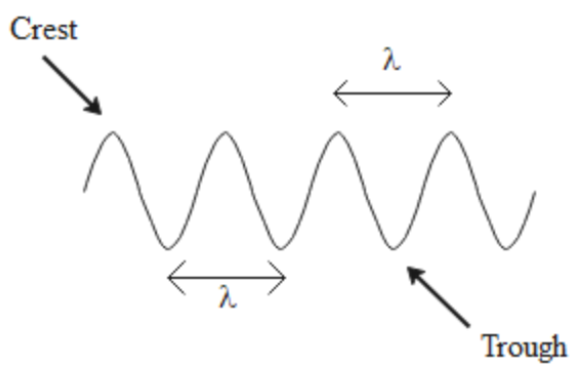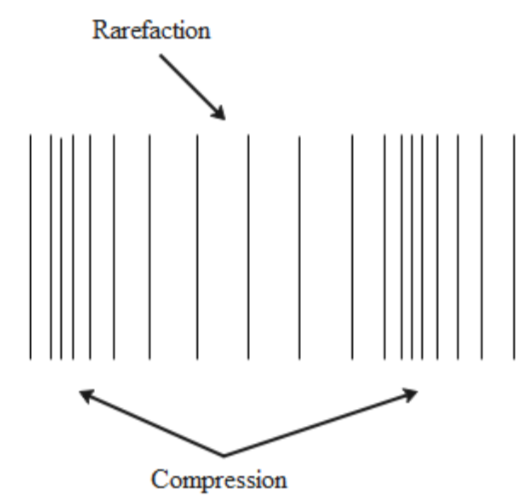
Elastic waves in solid are:
A. Transverse only
B. Longitudinal only
C. Either transverse or longitudinal
D. Neither transverse nor longitudinal
Answer
504.3k+ views
Hint: Elastic waves are formed in solids. We must know whether longitudinal waves and transverse waves can travel in a solid or not. In longitudinal waves, the constituents of solid are displaced along the direction of motion of the wave while in a transverse wave, the constituents of solid are displaced perpendicular to the direction of motion of the wave
Detailed step by step solution:
Let us discuss the longitudinal waves and transverse waves first.
The transverse waves are those waves in which the particles of the medium, through which the wave travels, are displaced in the direction perpendicular to the direction of the propagation of the waves. It looks like following

We have the maxima called crests and minima called troughs. They do not need a material medium to travel. They can travel only inside the solids or on the surface of a liquid and not inside the liquid.
The longitudinal waves are those waves in which the particles of the medium, through which the wave travels, are displaced in the direction parallel to the direction of the propagation of the waves. It looks like following

We have the maxima called compression and minima called rarefaction. They need a material medium to travel. These waves have the ability to travel in all types of mediums.
Elastic waves are waves that travel through a solid material. Now based on the nature of the longitudinal waves and transverse waves we discussed above, both of these waves can be formed in the solids. Hence the correct answer is option C that elastic waves in solid are either longitudinal or transverse.
Note: The molecules in a medium are bound to each other by elastic forces. When the positions of these atoms or molecules are disturbed they exhibit a spring-like elastic motion. That is why the disturbances are known as elastic waves.
Detailed step by step solution:
Let us discuss the longitudinal waves and transverse waves first.
The transverse waves are those waves in which the particles of the medium, through which the wave travels, are displaced in the direction perpendicular to the direction of the propagation of the waves. It looks like following

We have the maxima called crests and minima called troughs. They do not need a material medium to travel. They can travel only inside the solids or on the surface of a liquid and not inside the liquid.
The longitudinal waves are those waves in which the particles of the medium, through which the wave travels, are displaced in the direction parallel to the direction of the propagation of the waves. It looks like following

We have the maxima called compression and minima called rarefaction. They need a material medium to travel. These waves have the ability to travel in all types of mediums.
Elastic waves are waves that travel through a solid material. Now based on the nature of the longitudinal waves and transverse waves we discussed above, both of these waves can be formed in the solids. Hence the correct answer is option C that elastic waves in solid are either longitudinal or transverse.
Note: The molecules in a medium are bound to each other by elastic forces. When the positions of these atoms or molecules are disturbed they exhibit a spring-like elastic motion. That is why the disturbances are known as elastic waves.
Recently Updated Pages
Master Class 11 Economics: Engaging Questions & Answers for Success

Master Class 11 Business Studies: Engaging Questions & Answers for Success

Master Class 11 Accountancy: Engaging Questions & Answers for Success

Master Class 11 English: Engaging Questions & Answers for Success

Master Class 11 Computer Science: Engaging Questions & Answers for Success

Master Class 11 Maths: Engaging Questions & Answers for Success

Trending doubts
State and prove Bernoullis theorem class 11 physics CBSE

1 ton equals to A 100 kg B 1000 kg C 10 kg D 10000 class 11 physics CBSE

State the laws of reflection of light

One Metric ton is equal to kg A 10000 B 1000 C 100 class 11 physics CBSE

1 Quintal is equal to a 110 kg b 10 kg c 100kg d 1000 class 11 physics CBSE

Difference Between Prokaryotic Cells and Eukaryotic Cells




